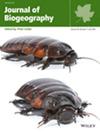Spatial Pattern of Active Pollination in Ficus: Younger Floral Adapting to Relatively Dry and Warm Condition
Abstract
Aims
Pollination plays a fundamental role in structuring the reproductive strategies and related traits of host plants. Active pollination is only observed in nursery mutualistic systems. However, the mechanisms underlying their maintenance are unclear. We aimed to explore the underlying factors shaping its global distribution pattern in Ficus species specifically putting forward three questions: (1) are actively-pollinated Ficus species more concentrated in areas with older Ficus floras? (2) Is active pollination better represented in areas with higher and more stable, less seasonal temperatures? (3) And is active pollination also more strongly represented in arid areas?
Location
Global.
Time Period
Current.
Major Taxa Studied
Ficus and pollinating fig wasps.
Methods
Using the data of 240 species, we constructed global distribution maps of actively- and passively-pollinated Ficus species and estimated their proportions in 80 × 80 km grid cells. We assessed the relative contribution of climate conditions, sexual systems and phylogenetic ages to the geographic variation in frequencies of active pollination using spatial autocorrelation analysis, a spatial linear model and structural equation models.
Results
Neither active nor passive pollination is randomly distributed. Actively-pollinated Ficus are more prevalent in regions with a higher proportion of recently divergent Ficus floral elements. Actively-pollinated species are also more concentrated at lower latitudes with higher and more stable temperatures, and in arid areas.
Main Conclusions
Our study provides a comprehensive overview of the geographical distribution of pollination modes and sexual systems in Ficus species. Both evolutionary history and current climate are related to the geographic distributions of pollination modes. Active pollination is more prevalent in lineages that diverged recently in the evolutionary history of Ficus and is more associated with relatively dry and warm climates.

 求助内容:
求助内容: 应助结果提醒方式:
应助结果提醒方式:


